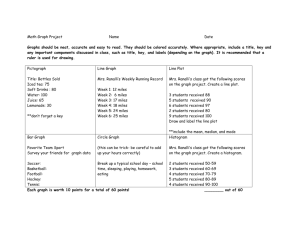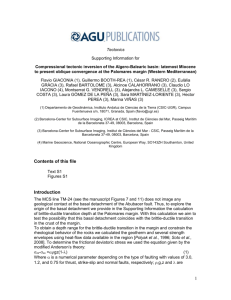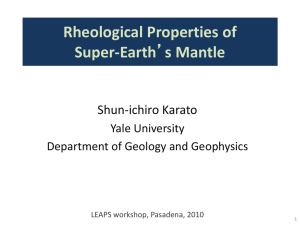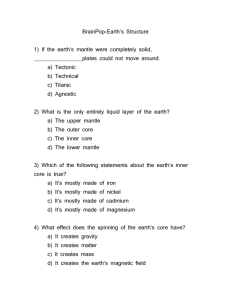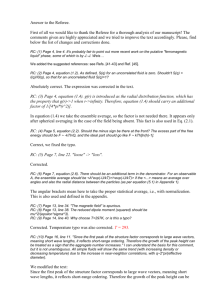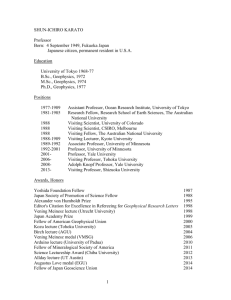ggge20790-sup-0001-2015GC005847-SupInfo
advertisement
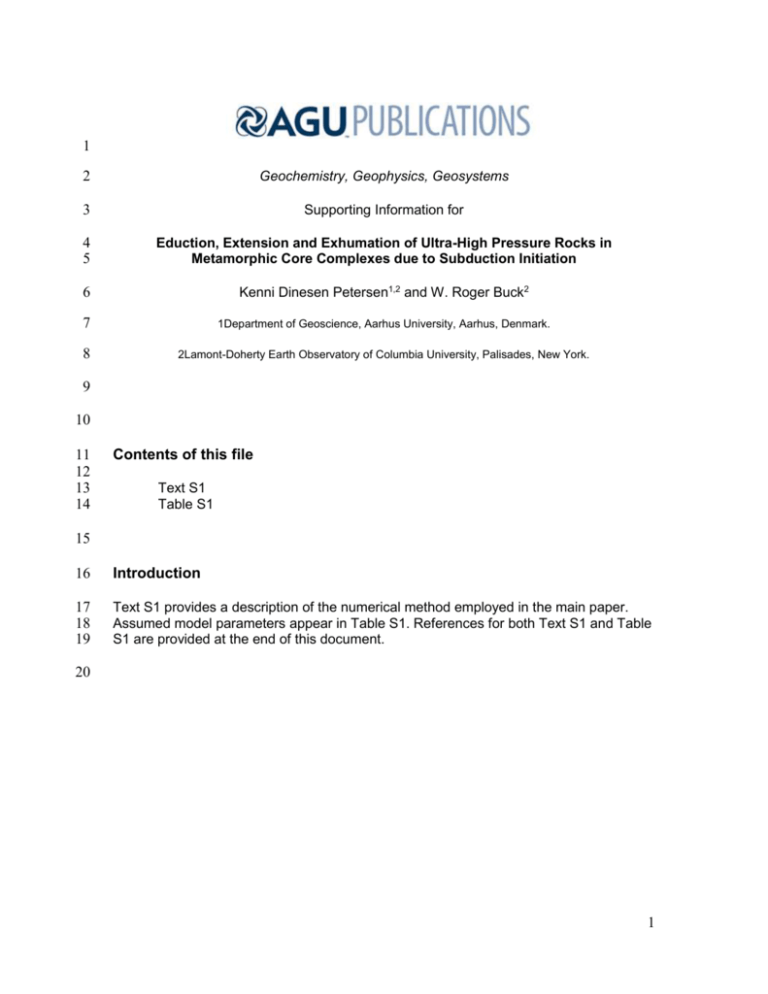
1 2 Geochemistry, Geophysics, Geosystems 3 Supporting Information for 4 5 Eduction, Extension and Exhumation of Ultra-High Pressure Rocks in Metamorphic Core Complexes due to Subduction Initiation 6 Kenni Dinesen Petersen1,2 and W. Roger Buck2 7 1Department of Geoscience, Aarhus University, Aarhus, Denmark. 8 2Lamont-Doherty Earth Observatory of Columbia University, Palisades, New York. 9 10 11 12 13 14 Contents of this file Text S1 Table S1 15 16 Introduction 17 18 19 Text S1 provides a description of the numerical method employed in the main paper. Assumed model parameters appear in Table S1. References for both Text S1 and Table S1 are provided at the end of this document. 20 1 21 22 Text S1. 23 The code is based on the marker-in-cell technique described in Gerya [2010] and 24 represents simultaneous viscous, elastic and plastic (brittle) deformation under the 25 assumption of conservation of energy, momentum and mass in 2 dimensions (i=1,2): 26 xi 27 28 Model Description and Numerical Method T DT k c Hr H A HS xi Dt ij' x j v j x j gi (1) P 0 xi (2) 0 (3) 29 1 ' Where ij is the deviatoric stress tensor, v j is the velocity field vector, P kk is 30 pressure and H r H A H S is the total rate of energy change due to radiogenic, adiabatic 31 and shear heating respectively. 32 adiabatic heat production is approximated [Gerya and Yuen, 2003a] as Ha≈Tαvzg. 33 1 v Strain rate is related to the velocity field by ij i j and is assumed to be the 2 x j xi 34 mutual contribution from brittle, elastic and viscous deformation: 35 36 Where the plastic multiplier, χ is nonzero only if II yield which is the Mohr-Coulomb 37 failure limit: 38 yield C P sin( ) 39 The brittle strength is taken to decrease with increasing brittle strain though a linear 40 reduction of the friction angle [e.g. Buiter et al., 2006] until a value of 0 is reached at a 41 strain of 0.1. It is this strain weakening that allows for a localized interface between the 42 upper and lower plates of a subduction zone. The viscous rheology depends on 43 composition, temperature, pressure and stress: 2 DT is the material time derivative of temperature. The Dt ' ij ' ij elastic ' ij plastic ' ij viscous v ' ij' 1 D ij 1 ij' 2 Dt 2 II 2 ( viscous) (4) (5) 2 1 E PV exp RT 44 45 Following Duretz et al. [2011] we also account for the effect of exponential creep in the 46 mantle by calculating an effective viscosity that is consistent with the flow law of 47 Katayama and Karato [2008]: 48 H Ap II2 exp RT 49 Practically, this is implemented such that this mechanism activates and predominates 50 when the effective viscosity for exponential creep is less than that for power-law creep. 51 Densities are temperature-dependent, and for the mantle we employ a temperature- 52 dependent coefficient of thermal expansion [Gillet et al., 1991]. For remaining lithologies 53 we assume a constant (with temperature) coefficient of expansion [McKenzie et al., 54 2005]. Following the Boussinesq approximation [Ranalli, 1995], density changes due to 55 temperature changes are assumed to affect only the momentum equation (2), but are 56 ignored in the continuity equation (3). 57 For definitions of the remaining terms we refer to earlier works using similar 58 nomenclature and methods [Gerya and Yuen, 2007; Petersen et al., 2010] and Table S1. 59 A stress-free surface is represented by employing a ‘sticky-air’ approach [Crameri et al., 60 2012] by letting the initial upper 40 km of the modelling domain have little mass and low 61 (relative to the time scale of thermal evolution of the lithosphere) viscosity of 1020 Pa s. 62 Furthermore, we ensure that negligible surface stresses form by also setting a plastic yield 63 limit of 0.1 MPa (similar to the numerical precision of the modelling method) for the ‘air’ 64 layer [Petersen et al., 2015]. This renders the surface effectively stress-free even during 65 rapid surface movements and dynamically limits the effective viscosity only when 66 needed (a beneficial property for especially iterative thermo-mechanical solution 67 strategies). The numerical precision of 0.1 MPa of the modelling method is specified 68 explicitly for multigrid iterations that are repeated until residuals of both the momentum 69 and continuity equations correspond to errors that are less than this amount [Taras Gerya, 70 pers. comm.]. n 1 2 A II 1 II p2 (6) 2 (7) 3 71 Surface processes are represented as a simple diffusion process [Kooi and Beaumont, 72 1994], but with a diffusivity of only 10-8m2/s. For a time scale of 20 Myr this corresponds 73 to a length scale of ~3.5 km. This implies that such diffusion does not affect large-scale 74 topographic variation, but only local areas with high convexity. In particular, trenches 75 that form upon subduction initiation will be affected by this by having their relief 76 smoothed. Practically, erosion and sedimentation are implemented by converting markers 77 to air or sediment, respectively [Gerya and Yuen, 2003b]. The employment of such short- 78 wavelength erosion/sedimentation appears to increase numerical stability in the present 79 modelling experiments. 4 80 Table S1. Assumed model parameters. Description Symbol Value Viscosity Η 1020 Pas Yield strength σy 0.1 MPa Shear modulus Μ 1 GPa Density Ρ 1 kgm-3 Angle of internal friction [Buiter et al., 2006] φ Cohesion [Ranalli, 1995] C 36° (linearly reduced to 0° as plastic strain approaches 0.5) 10 MPa Coefficient of thermal expansion [Parsons and Sclater, 1977] Isobaric heat capacity α 3.28·10-5K-1 Cp 800 Jkg-1K-1 Shear modulus μ 25 GPa Reference density at 273 K ρ0 2800 kgm-3 Radiogenic heat production Hr 1.0 μWm-3 Thermal conductivity k 2.5 Wm-1K-1 Activation energy [Ranalli, 1995] E 238 kJmol-1 Power-law exponent [Ranalli, 1995] n 3.2 Power-law constant [Ranalli, 1995] A 2.08·10-23Pa-ns-1 Reference density at 273 K ρ0 2300 kgm-3 Radiogenic heat production Hr 1.0 μWm-3 Activation energy [Ranalli, 1995] E 154 kJmol-1 Power-law exponent [Ranalli, 1995] n 2.3 Power-law constant [Ranalli, 1995] A 5.07·10-18Pa-ns-1 Thermal conductivity k 2.0 Wm-1K-1 Reference density at 273 K ρ0 3000 kgm-3 Radiogenic heat production Hr 1.0 μWm-3 Thermal conductivity k 2.5 Wm-1K-1 Activation energy [Ranalli, 1995] E 238 kJmol-1 Power-law exponent [Ranalli, 1995] n 3.2 Power-law constant [Ranalli, 1995] A 2.08·10-23Pa-ns-1 Reference density at 273 K ρ0 3300 kgm-3 Coefficient of thermal expansion [Gillet et al., 1991] α 2.77·10-5K-1+0.97·10-8K-2T+0.32 KT-2 Thermal conductivity [McKenzie et al., 2005] k 4.08 Wm-1K-1(298K/T)0.406 Isobaric heat capacity [Berman and Brown, 1986] Cp [1.69·10-3-1.42·104(T/K)0.5-8.27·108(T/K)-3] Jkg-1K-1 Shear modulus [Karato and Wu, 1993] μ 80 GPa Activation energy [Karato and Wu, 1993] E 540 kJmol-1 Power-law exponent [Karato and Wu, 1993] n 3.5 Power-law constant [Karato and Wu, 1993] A 2.41·10-16Pa-ns-1 Activation volume [Karato and Wu, 1993] V 15 cm3mol-1 Freely deforming upper layer All lithologies (except ‘seeds’) Crust (all lithologies) -Continental (upper and lower) -Sediments -Oceanic Mantle -Dislocation creep -Exponential creep 5 81 82 83 84 85 Exponential-law constant [Katayama and Karato, 2008] Ap 6.31·10-5Pa-2s-1 Peierls stress [Katayama and Karato, 2008] σp 2.87 GPa Activation enthalpy at zero stress [Katayama and Karato, 2008] H 512 kJmol-1 Seeds have identical rheological properties as the mantle except that plastic yield limit is 1 MPa. 6 86 87 88 89 90 91 92 93 94 95 96 97 98 99 100 101 102 103 104 105 106 107 108 109 110 111 112 113 114 115 116 117 118 119 120 121 122 123 124 125 126 127 128 129 130 References Berman, R. G., and T. H. Brown (1986), Heat capacity of minerals in the system Na2O-K2O-CaO-MgO-FeO-Fe2O3-Al2O3-Sio2-TiO2-H2O-CO2: representation, estimation, and high temperature extrapolation, Contributions to Mineralogy and Petrology, 94(2), 262. Buiter, S. J. H., A. Y. Babeyko, S. Ellis, T. V. Gerya, B. J. P. Kaus, A. Kellner, G. Schreurs, and Y. Yamada (2006), Comparison of model results for a shortening and an extension experiment, Geological Society Special Publication, 29-64. Crameri, F., H. Schmeling, G. Golabek, T. Duretz, R. Orendt, S. Buiter, D. May, B. Kaus, T. Gerya, and P. Tackley (2012), A comparison of numerical surface topography calculations in geodynamic modelling: An evaluation of the ‘sticky air’method, Geophysical Journal International, 189(1), 38-54. Duretz, T., T. V. Gerya, and D. A. May (2011), Numerical modelling of spontaneous slab breakoff and subsequent topographic response, Tectonophysics, 502(1–2), 244256. Gerya, T. V. (2010), Introduction to Numerical Geodynamic Modelling, 345 pp., Cambridge University Press, Cambridge. Gerya, T. V., and D. A. Yuen (2003a), Characteristics-based marker-in-cell method with conservative finite-differences schemes for modeling geological flows with strongly variable transport properties, Physics of the Earth and Planetary Interiors, 140(4), 293-318. Gerya, T. V., and D. A. Yuen (2003b), Rayleigh–Taylor instabilities from hydration and melting propel ‘cold plumes’ at subduction zones, Earth and Planetary Science Letters, 212(1–2), 47-62. Gerya, T. V., and D. A. Yuen (2007), Robust characteristics method for modelling multiphase visco-elasto-plastic thermo-mechanical problems, Physics of the Earth and Planetary Interiors, 163(1-4), 83-105. Gillet, P., P. Richet, F. Guyot, and G. Fiquet (1991), High-temperature thermodynamic properties of forsterite, Journal of Geophysical Research, 96(B7). Karato, S. I., and P. Wu (1993), Rheology of the upper mantle: A synthesis, Science, 260(5109), 771-778. Katayama, I., and S. i. Karato (2008), Low-temperature, high-stress deformation of olivine under water-saturated conditions, Physics of the Earth and Planetary Interiors, 168(3-4), 125-133. Kooi, H., and C. Beaumont (1994), Escarpment evolution on high-elevation rifted margins: insights derived from a surface processes model that combines diffusion, advection, and reaction, Journal of Geophysical Research, 99(B6), 12,191-112,209. McKenzie, D., J. Jackson, and K. Priestley (2005), Thermal structure of oceanic and continental lithosphere, Earth and Planetary Science Letters, 233(3-4), 337-349. Parsons, B., and J. G. Sclater (1977), An analysis of the variation of ocean floor bathymetry and heat flow with age, J. Geophys. Res., 82(5), 803-827. Petersen, K., J. Armitage, S. Nielsen, and H. Thybo (2015), Mantle temperature as a control on the time scale of thermal evolution of extensional basins, Earth and Planetary Science Letters, 409, 61-70. 7 131 132 133 134 135 136 Petersen, K. D., S. B. Nielsen, O. R. Clausen, R. Stephenson, and T. Gerya (2010), Small-Scale Mantle Convection Produces Stratigraphic Sequences in Sedimentary Basins, Science, 329(5993), 827-830. Ranalli, G. (1995), Rheology of the Earth, 2 ed., Chapman & Hall, London. 8
